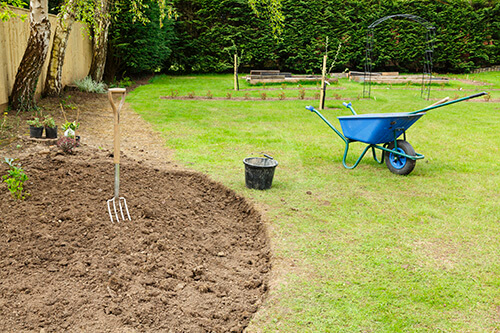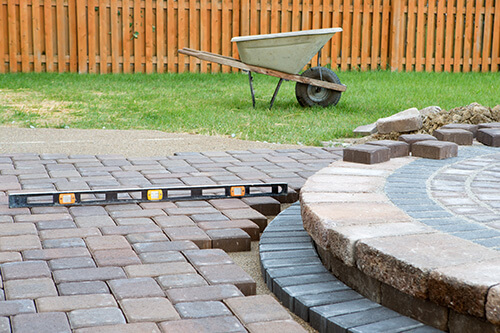Budgeting for a landscaping project can often be challenging. However, with proper planning it is possible to stick to your budget and complete the project without breaking the bank. Setting realistic goals and considering the costs of materials, labour, and other factors can help you plan ahead and get an accurate estimate of how much your project will cost. With careful consideration of these costs, you can better allocate resources and prioritize what needs to be done with more efficiency while still staying within your budget.
Determine Goals
 Establishing landscaping project goals is essential for a successful outcome. Evaluate your space carefully and decide on the purpose of the area, then prioritize which elements need to be addressed first. Consider what plants, design features, and materials best fit your needs and determine how much time you are willing to invest in maintaining the space.
Establishing landscaping project goals is essential for a successful outcome. Evaluate your space carefully and decide on the purpose of the area, then prioritize which elements need to be addressed first. Consider what plants, design features, and materials best fit your needs and determine how much time you are willing to invest in maintaining the space.
It is important to set realistic goals that are achievable within your desired timeline and budget. With clear objectives in mind, you can begin planning out the specific details of your project.
Establish an Acceptable Timeline
Creating a timeline for your landscaping project is an important step in ensuring that your project elements are addressed in order of priority. While many projects can be completed over the course of a few days, others may need to be stretched over weeks, months, or multiple seasons to make the project budget more manageable.
Dividing the project into phases will not only help you manage your budget, but will also help you create a space over time that is beyond what you even originally anticipated. In addition, extending your timeline increases your ability to address any unexpected delays or problems that may occur along the way.
Setting Priorities
 Determining priorities will help significantly with budgeting for a landscaping project. Prioritize project elements that are going to provide maximum value, such as plants and hardscape features that will add both aesthetic appeal and functionality. Depending on the size of your project and budget, you may choose to do some work yourself while outsourcing other elements that require more expertise or specialized tools.
Determining priorities will help significantly with budgeting for a landscaping project. Prioritize project elements that are going to provide maximum value, such as plants and hardscape features that will add both aesthetic appeal and functionality. Depending on the size of your project and budget, you may choose to do some work yourself while outsourcing other elements that require more expertise or specialized tools.
When establishing priorities, it is important to consider the long-term maintenance costs associated with each element. While making sure to create a space that meets all of your needs, try not to neglect those items which need maintenance in order for the project to remain successful in the long run.
Use a Landscape Planning App
Employing a landscape planning app can help you determine the most cost-effective way to complete your project. Landscape planning apps let you visualize how your space will look, providing helpful tools for budgeting and analyzing maintenance costs over time.
Tools like this are especially useful for larger projects with more complex elements, such as water features or hardscaping materials. With a comprehensive overview of all the elements needed to complete the project, it is easier to stay on track while remaining within your allotted budget.
Creating a Budget
 With the aforementioned steps completed, you’re much better prepared for budgeting for a landscaping budget. Research prices for materials and labor before making any purchases so you have an idea of how much everything will cost when estimating your project budget. Don’t forget to factor in taxes, fees, and permits if applicable.
With the aforementioned steps completed, you’re much better prepared for budgeting for a landscaping budget. Research prices for materials and labor before making any purchases so you have an idea of how much everything will cost when estimating your project budget. Don’t forget to factor in taxes, fees, and permits if applicable.
Make sure to account for any unexpected expenses along the way as well as potential costs associated with maintenance and upkeep after completion of the project. It is always better to overestimate your budget than underestimate it so you don’t get stuck with a large bill at the end of the process.
With proper planning and preparation, landscaping projects can be completed without breaking the bank. Setting realistic goals, creating an acceptable timeline, prioritizing project elements and creating a detailed budget are all key components in ensuring that your project is successful within both its timeline and budgetary constraints. With careful consideration of these factors, you can create a beautiful, usable landscape within budget.
Use Professional Services When Necessary
If you’re a DIYer, you might opt to do as much work yourself as possible in order to save on labour costs. However, some aspects of landscaping may be better left up to professionals depending on their complexity and required tools. Hiring a professional landscaping company also ensures that the project meets all local codes and regulations for safety. If you don’t want to go it alone, contact us and share your landscaping goals.

